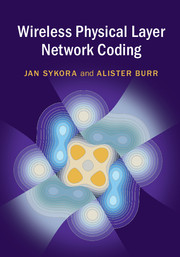Book contents
- Frontmatter
- Contents
- Preface
- Mathematical Symbols
- Abbreviations
- Part I Motivation and Gentle Introduction
- 1 Introduction
- 2 Wireless Physical Layer Network Coding: a Gentle Introduction
- Part II Fundamental Principles of WPNC
- Part III Design of Source, Relay, and Destination Strategies
- Appendix A Background Theory and Selected Fundamentals
- References
- Index
1 - Introduction
from Part I - Motivation and Gentle Introduction
Published online by Cambridge University Press: 01 February 2018
- Frontmatter
- Contents
- Preface
- Mathematical Symbols
- Abbreviations
- Part I Motivation and Gentle Introduction
- 1 Introduction
- 2 Wireless Physical Layer Network Coding: a Gentle Introduction
- Part II Fundamental Principles of WPNC
- Part III Design of Source, Relay, and Destination Strategies
- Appendix A Background Theory and Selected Fundamentals
- References
- Index
Summary
Introduction
Wireless networks are becoming more and more ubiquitous in the modern world, and more and more essential to today's society. In 30 years they have progressed from the province of a tiny minority of the world's population in only the most developed nations, to the point where there are very nearly as many wireless subscriptions as people in the world [24]. The services offered have extended from very limited speech services at the introduction of first-generation mobile systems in 1985, to broadband Internet access and full motion video today. Moreover, we are at the point where wireless networks will extend beyond connecting people (of whom there are a limited number), to connecting their devices – an effectively unlimited number. Some believe that there are already more devices than people connected to the Internet, and predictions that 50 billion or more devices will be connected by 2020 are circulating widely [60]. Of course, that is only the start.
All this implies that the density of wireless networks will inevitably increase. To provide telecommunication services to the human populations of our cities, at continually increasing data rates, will require increasing numbers of access points, for which backhaul will become an increasing problem, and require more widespread use of wireless backhaul. The devices will also form a network many times as dense as any current wireless networks, also likely to require connection to the core network. In both cases it is likely that the current point-to-multipoint architecture of wireless networks, exemplified by both cellular and WiFi systems, will be replaced by a multi-hop mesh network architecture.
The concept of the mobile ad-hoc network (MANET), one of the best-established concepts in wireless mesh networking, has been in existence for many years [9], yet has not really fulfilled its predicted potential. There are very few wireless networks in use today that implement a truly multi-hop networking approach. There seems to be a barrier to the practical implementation of multi-hop wireless networking that will surely have to be overcome in order to implement the ultra-dense wireless networks that are likely to be required in the near future.
- Type
- Chapter
- Information
- Wireless Physical Layer Network Coding , pp. 3 - 14Publisher: Cambridge University PressPrint publication year: 2018



